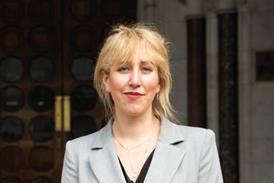Cost appeals
The main issues arising from the summaries from the Supreme Court Taxing Office (SCTO) of recent costs appeals Nos 6-14 of 2000
No.6 of 2000: Maes Finance Ltd v WG Edwards & PartnersThis appeal considered the Court of Appeal decision in Lloyds Banks Ltd v Eastwood [1965] 1 Ch 112.
Elias J confirmed that it was not open for him to depart from the Eastwood case both in relation to the appropriate hourly rate and the uplift that could be charged by an employed solicitor.
Elias J also reaffirmed the principle that there may be special circumstances where a court may apply a different approach if reasonably plain that the indemnity principle would be infringed.
The Eastwood principle is also considered in the cost appeal in the case of Cole v British Telecommunications PLC (No.14/2000)
No.7 of 2000: Mealing McLeod v Common Professional Examination BoardThe claimant, a litigant in person appealed on three principle grounds.
The first related to the appropriate allowances under r.48.6 of the CPR.
Morris v Wiltshire and Woodspring District Council (no.
3 of 1998) was accepted as useful guidance but the judge took the view that r.48.6(4) suggested that a litigant in person could be allowed more time than a solicitor to complete particular tasks within the litigation.
Secondly, the claimant's ground that as the costs of the defendant were substantially in excess of the costs allowed to her, the former must be disproportionate under CPR r.44.5 was described as misconceived.
Thirdly, the claimant submitted that the costs judge was wrong to restrict her costs to 9.25 per hour.
However, following the case of Mainwaring v Goldtech Investments Ltd (1997) 1 All ER 467, no more was allowed as the claimant had not provided enough evidence of any loss of earnings.
No.8 of 2000: Armitage v NurseThis case involved a review of counsel's fees in a legal aid only matter.
Both leading and junior counsel's fees were increased.
The court noted that certain material, namely, a detailed note from counsel as to the work which they had done justifying the fees claimed was not available at the original assessment and that in future it would be helpful to the court and wise from the point of counsel to furnish such additional information at the stage of the detailed assessment.
No.9 of 2000: John Anthony v Ellis & Fairbairn (A Firm)This case involved a detailed assessment under s.70 of the Solicitors Act 1974 and an appeal by the claimant.
The first issue was whether the judge could entertain witness statements as to the liability to pay the solicitor's bill.
As no witness evidence had been available at the detailed assessment, no findings of fact were made by the costs judge which could be subject to any appeal.
The judge refused to admit the witness statements.
The second point was whether the defendant should be bound by an estimate of costs in the sum of 2,500 plus VAT given earlier in the proceedings.
The judge, following the case of Wong v Vizards (1997) 2 Costs LR 46 said that a bill twice the size of the estimate should not be enforceable.
As a result the solicitors had failed to recover more than 80% of their costs and the cost order in their favour at the cost assessment below was reversed, although the judge refused to award the claimant all of his costs of the appeal.
No.10 of 2000: RM Broudie & Co v The Lord ChancellorThis criminal review concerned the interpretation of sub para 2(4)(c) of the Legal Aid Act 1988 which says that: 'Representation means representation for the purposes of proceedings and includes: (c) In the case of criminal proceedings, advise and assistance as to any appeal.'
The judge confirmed the view of both the costs judge and the determining officer that this section means that the legal aid order for the Crown Court proceedings did not extend beyond the refusal of leave to appeal by the single judge.
The judge did not consider that he was bound by the Court of Appeal (Criminal Division) in R v Gibson (1983) 77 CAR 151.
No.11 of 2000: Paragon Finance Ltd v Rosling KingThe court in this case considered the implications of CPR r.25.1(1)(m).
It considered whether there was an independent equitable jurisdiction which overrode the solicitor's lien where the claimant had terminated the retainer, as opposed to the solicitor discharging himself where it is clear, for instance, from the case of Ismail v Richards Butler (A Firm) (1996) 3 WLR 129, that the jurisdiction did exist.
However, the court did not decide the point as it decided that the balance of prejudice fell in the solicitor's favour and the judge dismissed the application.
No.12 of 2000: Hornsby v Clarke Kenneth Leventhal (a firm)This case involved the fraudulent activities of an employee of the defendant.
The appellants were legally aided and were two of 14 claimants who brought an action against the defendants.
The case lost at first instance and seven of the 14 claimants appealed to the Court of Appeal, which upheld the first instance decision.
Following taxation, the matter went to a cost appeal.
Nine out of 12 grounds of appeal were dismissed and the remaining three were upheld.
In relation to the ground relating to counsel's fees for the skeleton argument, brief and refreshers the judge found that the taxing master had given disproportionate weight to the fees claimed by and allowed to the other appellants' leading and junior counsel which were considerably lower than those claimed by leading and junior counsel for the Hornsby's.
In addition the judge increased the percentage for care and conduct allowed to the solicitors.
A 95% uplift had been claimed by the Hornsby Solicitors against 50% by the solicitors for other appellants for the Court of Appeal matter.
The taxing master had allowed 50% and it was seen as significant that, as the appeal had been unsuccessful, and the appellants had been ordered to pay the costs of the appeal which were met by the Legal Aid Board, this had lead to a restriction in their claim for care and conduct for 50%.
It was held that the taxing master had paid too much attention to that fact and too little to the fact that different solicitors to those who were instructed in the lower court appeared in the Court of Appeal on behalf of the Hornsby's.
Care and conduct was increased to 80%.
No.13 of 2000: Arab Monetary Fund v HashimThis appeal related to a complex Chancery case where two issues were before the judge, namely, percentages for care and conduct and time allowed for work carried out on certain documents.
Of significance to care and conduct was the fact that the matter was conducted by one partner with one assistant whereas the claimants were represented by a large team.No.14 of 2000: Cole v British Telecommunica-tions Plc (2000)
This was an appeal to the Court of Appeal of the decision of Mr Justice Alliott sitting with assessors (No.
11 of 1999).
The Court of Appeal upheld the earlier decision which was in relation to Re: Eastwood.
The judgment was to the effect that Re: Eastwood established that the conventional method appropriate to taxing the bill of a solicitor in private practice was also appropriate for the bill of an in-house solicitor except where in special cases it is reasonably plain that that method would infringe the indemnity principle.
Such a special case will arise where a different sum could be identified which was adequate to cover the cost incurred.
However, that did not justify detailed investigation into every case.
l Copies of the SCTO summaries are available from the Law Society library, tel: 020 7320 5625.



























No comments yet